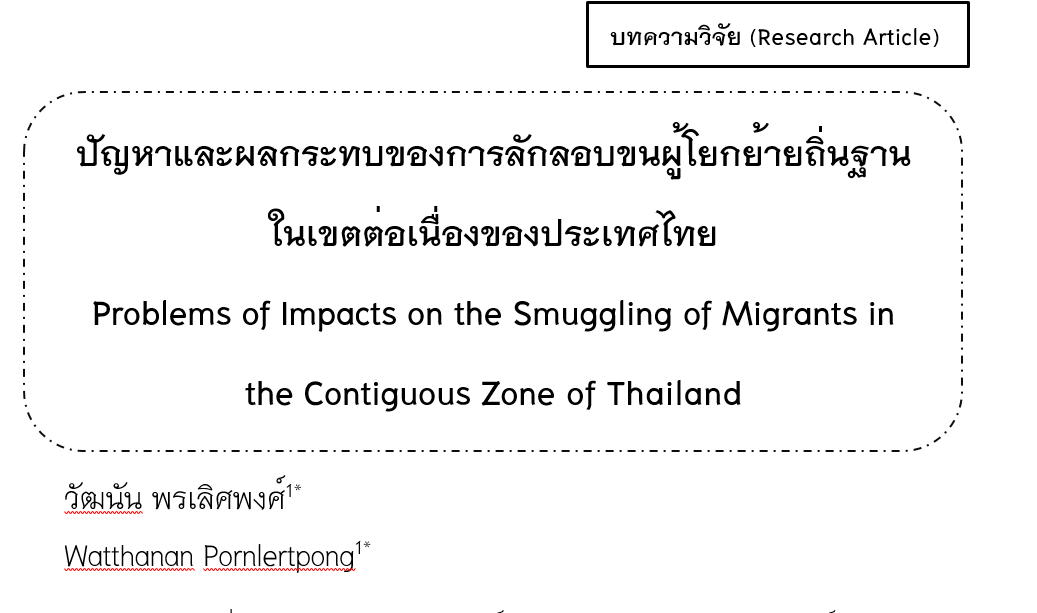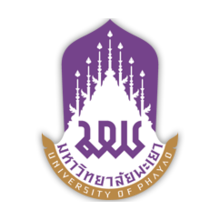Problems and Impacts on the Smuggling of Migrants in the Contiguous Zone of Thailand
Keywords:
Smuggling, Migrants, Contiguous ZoneAbstract
This research aims to study the situation of migrants smuggling problem, scope of jurisdiction and law enforcement in the contiguous zones between Thailand and neighbouring countries in order to find appropriate practical guidelines for Thailand. Upon the study, it has been found that the causes of migrants smuggling problem are; the domestic law on contiguous zones remains inexplicit as well as ambiguous contained in the Article 33 of the United Nations Convention on the Law of the Sea, 1982. The aforesaid causes not only create problem but also reproduce negative consequences, so the government required to work out on the issue hastily to protect national interests.
The author suggests that the specific rules, measures and laws shall be enforced among the contiguous zones. Either, the relevant laws in 4 areas, namely, customs law, financial law, immigration law and sanitary law required to be amended in terms of extending their coverage to the contiguous zones. Particularly, the immigration law amendment as it is directly concerned to the migrants smuggling problem. In addition, the government should imply meaning of the Article 33 for the upmost benefit of the state; the third practice of International guidelines should be implemented to empower the customs law, financial law, immigration law and sanitary law as measures for both prevention and punishment in case any offense occurred in contiguous zones. Furthermore, due to the third practice is match to the purpose of the Article 33 the most as it defines the contiguous zones as a buffer and checking zone and able to effectively solve the migrants smuggling problem in the Contiguous Zone of Thailand.
References
กุศล สุนธรธาดา. (2540). กระบวนการจ้างแรงงานข้ามชาติที่ลักลอบเข้าเมืองและความคิดเห็นของภาครัฐและเอกชนที่เกี่ยวข้อง. นครปฐม: สถาบันวิจัยประชากรและสังคม มหาวิทยาลัยมหิดล.
เกริกเกรียงไกร ภิญโญดม. (2554). กระบวนการลักลอบเข้าเมืองของคนต่างด้าวตามแนวชายแดน จังหวัดหนองคาย. (สารนิพนธ์ปริญญามหาบัณฑิต). ขอนแก่น: วิทยาลัยการปกครองท้องถิ่น มหาวิทยาลัยขอนแก่น.
เกียรติพร อำไพ. (2540). ปัญหาการออกและการบังคับใช้กฎหมายในเขตต่อเนื่องของประเทศไทย ศึกษากรณีน้ำมันเถื่อน. (วิทยานิพนธ์ปริญญานิติศาสตรมหาบัณฑิต). กรุงเทพมหานคร: บัณฑิตวิทยาลัย จุฬาลงกรณ์มหาวิทยาลัย.
จิตติ ติงศภัทิย์. (2525). กฎหมายอาญาภาค 1. กรุงเทพฯ: สำนักอบรมศึกษากฎหมายแห่งเนติบัณฑิตยสภา.
บุญชัย มรินทร์พงษ์. (2556). ผู้อพยพทางเรือ: ภารกิจของทหารเรือกับปัญหาสิทธิมนุษยชน. วิทยาลัยรัฐธรรมนูญ สำนักงานศาลรัฐธรรมนูญ.
พรภพ อ่วมพิทยา. (2533). หลักกฎหมายระหว่างประเทศว่าด้วยเขตต่อเนื่อง: วิเคราะห์ปัญหาเขตอำนาจของรัฐชายฝั่ง. (ปริญญานิติศาสตร์มหาบัณฑิต). กรุงเทพฯ: คณะนิติศาสตร์ มหาวิทยาลัยธรรมศาสตร์.
ภุชงค์ ประดิษฐธีระ. (2555). การเข้าเป็นภาคี UNCLOS 1982 ของไทย. นาวิกศาสตร์,95(2), 22 - 25.
สถาบันวิจัยเพื่อพัฒนาประเทศไทย. (2550). โครงการศึกษาความต้องการแรงงานที่แท้จริง และการบริหารจัดการแรงงานต่างด้าวในภาคเกษตร ประมง กิจการต่อเนื่องจากประมง และก่อสร้าง. กรุงเทพฯ: สำนักพิมพ์มหาวิทยาลัยรามคำแหง.
United nations office on drugs and crime (UNODC). (2000). Protocol Against The Smuggling of Mogrants by Land, Sea and Air, Supplementing The United Nations Convention Aginst Transnational Organized Crime. Retrieved February 24, 2018, from https://www.unodc.org/documents/middleeastandnorthafrica/smuggling-migrants/SoM_Protocol_English.pdf
United Nations Office on Drugs and Crime (UNODC). (n.d.). Smuggling of migrants. Retrieved January 10, 2019, from https://www.unodc.org/southeastasiaandpacific/en/what-we-do/toc/smuggling-of-migrants.html
United Nations. (1982). United Nations Convention on the Law of the Sea. Retrieved June 3, 2017, from https://www.un.org/Depts/los/convention_agreements/texts/unclos/unclos_e.pdf

Downloads
Published
How to Cite
Issue
Section
License
ผู้นิพนธ์ต้องรับผิดชอบข้อความในบทนิพนธ์ของตน มหาวิทยาลัยพะเยาไม่จำเป็นต้องเห็นด้วยกับบทความที่ตีพิมพ์เสมอไป ผู้สนใจสามารถคัดลอก และนำไปใช้ได้ แต่จะต้องขออนุมัติเจ้าของ และได้รับการอนุมัติเป็นลายลักษณ์อักษรก่อน พร้อมกับมีการอ้างอิงและกล่าวคำขอบคุณให้ถูกต้องด้วย
The authors are themselves responsible for their contents. Signed articles may not always reflect the opinion of University of Phayao. The articles can be reproduced and reprinted, provided that permission is given by the authors and acknowledgement must be given.







